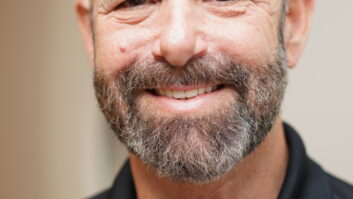
Origin Acoustics’ Jeremy Burkhardt poses in the soon-to-be full warehouse and training facility that his new company will share with Screen Innovations in Austin, TX.
When Jeremy Burkhardt returns to CEDIA EXPO next week as co-owner of audio start-up Origin Acoustics, he knows that he will have a lot to prove.
During an exclusive interview last month in Austin, TX, the former SpeakerCraft CEO made it clear that he wants the industry to look at Origin Acoustics as a truly innovative audio manufacturer, with products designed from scratch to rethink the old architectural loudspeaker design paradigm.
“The hardest thing we’re going to be faced with is, ‘Oh, it’s just SpeakerCraft again,’” Burkhardt said near the end of a three-hour conversation. “We have to overcome that, and that’s why we’ve worked so hard at creating truly different products, and coming up with new business tools for our dealers.”
And although physical hardware was not yet ready for display with just over a month to go until CEDIA EXPO, photographs and design drawings hinted at the innovative thinking that has gone into the company’s initial line of 60 products.
Along with his business partners, former SpeakerCraft owners Ed Haase and Ken Humphreys, Burkhardt showed how the company has engineered 8-inch speakers into 6-inch in-wall baffles, and 10-inch speakers into 8-inch baffles. Origin accomplished this feat by replacing the traditional dogleg mounting mechanism used to attach an in-ceiling speaker, with a zip-tie-inspired device, and by combining the most efficient loudspeaker elements available. Its in-ceiling speakers utilize ring radiator tweeters for better off-axis sound dispersion, its pivoting tweeters are positioned closer to the grille for more pivoting range, and its Kevlar cones are pre-stressed for better acoustical performance.
Burkhardt said that having no legacy designs to protect freed up Origin designers to create everything from scratch, and proper corporate funding enabled it to invest in custom tooling for its grille designs and to avoid buying commodity, off-the-shelf drivers.
And the company’s website and online order fulfillment and tracking system also promises to be one of the best in the business, showcasing Origin’s simplified sales incentive programs and pricing model.
Sharing Resources with Screen Innovations
Perhaps the most surprising revelation is that Origin Acoustics will be sharing ownership of its new Austin warehouse and training facility with Screen Innovations, and that SI had co-developed the company’s sleek website and order-fulfillment process. It was a partnership built out of a friendship between Burkhardt and SI CEO Ryan Gustafson, as well as a logical convenience.

The shell of the training and demo room that Origin Acoustics will share with Screen Innovations in Austin.“I’ve known Ryan for a long time, and he runs a really innovative company,” Burkhardt explained as Gustafson guided his crew in setting up the new facility during Burkhardt’s interview for this story. “I was looking for an operations partner [back-end production and order fulfillment], and he was looking to get into another building and liked the idea of sharing the cost of that investment.”
Gustafson offered as his perspective on the partnership, as well, saying that he hopes to learn from Burkhardt’s ability to inspire his dealers to partner with his company. “Our company tries to change the industry through our products, but he has always been The Guy to his dealers,” Gustafson noted. “There’s a lot we can learn from the way he leads, and both of us have a strong synergy from an operations standpoint.”
Origin Acoustics and SI have utilized a customized version of Netsuite for its website and order-fulfillment system. “Investing in those tools and our facility together gives us efficiencies and economies of scale,” Gustafson added. “When you’re looking to be lean and mean and efficient, there’s no reason to do it alone. Our buying power is better together.”
The SpeakerCraft Dream Team
The partnership between three former SpeakerCraft CEOs may seem more surprising, however, than the one between SI and Origin Acoustics. But Haase and Humphreys, who are both in their early 60s, actually have remained active and engaged in the audio industry since departing the company the high school best friends co-founded back in the 1970s, and they were enthusiastic about combine their strengths. COO Ed Haase directs operations in Austin, Ken Humphreys leads engineering out of Eugene, OR, and Burkhardt will guide the rest of his team back in Riverside, CA.





Haase most recently invented the lightspeaker being sold by Klipsch, and Humphreys has been an OEM speaker driver designer for years, having most recently served on the team at Portland-based Aperion Audio.
The arrangement allows the three audio veterans to focus on what they each do best. “When you have three people that give a shit as much as we do, it’s not like I’ll find myself saying, ‘Oh, that’s the ops guy’s responsibility; I have to make sure he’s doing his job,’ Burkhardt stated. “No, that’s my partner, and he’s going to do his job, and they both know I’m going to do my job.”
I spoke by phone with Humphreys, who said that the new company has “been a lot of fun,” and that he’s enjoyed not having to be constrained by “trying to evolve an existing product into something better.”
“We get to visualize things from scratch,” he stated.
Humphreys also has been working with his 26-year-old son Tyler, who will continue to serve as the company’s mechanical designer.
“I have some ideas, and Jeremy provides input into what the marketplace has been looking for, and then Tyler’s been really good at turning our vision into mechanical designs,” Humphreys explained. “Developing different ways for mounting the speaker so we don’t have as big of a footprint…all of these different mechanical designs come from this collaborative process.”
The Zip-Clip and Other Innovations
Of the many innovations from the Origin Acoustics team, the most eye-catching may be the removal of the traditional dogleg mounting system from the company’s premium in-ceiling speakers. Origin’s patent-pending Zip-Clip Mounting System resembles a zip-tie that clicks the speaker into place (click, click, click) and enables designers to reduce the size of the speaker structure by several inches because there’s no dogleg to flip out and clamp onto the wallboard. It also spreads the weight of the speaker over a larger area than typical mounting systems and creates more uniform pressure against the drywall, eliminating any warping or distortion of the speaker baffle.
The company’s Director Collection in-ceiling speakers offer a FocalPoint mid/tweeter module, which pivots at a sharper angles than previously possible, a full 36 degrees. The Director 80 and 100 series, specifically, feature this mid-tweeter assembly. Even before pivoting, the FocalPoint speakers produce 45 degrees of dispersion due to advancements in driver design (25 degrees used to be more typical.)
The Director Collection also features three drivers in a unique linear alignment. This three-way design allows for broader frequency response and better power handling, the company says. The 3-inch midrange is made of woven Kevlar and the tweeter is Origin’s proprietary DPSD radiator design.
One of Origin’s other audio performance innovations, DPSD (for Dual Plane Stabilized Diaphragm), is an advanced suspension system that allows the tweeter to play louder, cleaner, and with greater articulation. The DPSD also crosses over lower than a typical tweeter, allowing the midrange or woofer to operate comfortably within its range.

Origin’s Director Collection D108 in-ceiling speaker features many innovations, including the patent-pending Zip-Clip Mounting System.Another design element found in Origin woofers, is the X-Wave Woofer Surround. Here’s the concept: While in motion, frequencies between 700-1,400 Hz typically run up the cone of a woofer and are reflected back and forth from the center of the driver. This creates unwanted harmonic distortion. The X-Wave surround is meant to absorb these frequencies and reduce distortion and maintain driver stability. The design also maximizes cone area by reducing the width of the surround.
Some of the company’s speakers also feature what is called “progressive suspension.” According to Origin, as the driver travels to the limits of its excursion, this suspension system, which is made up of the spider and the surround, becomes more rigid, exerting more control on the movement of the cone. The result, the company says, is increased, clean power output throughout the driver’s frequency range.
For the company’s Composer Collection of in-wall speakers, the designers came up with a spring-loaded tool-less system, called SpringLock, to attach the speaker to the wall. The speaker assembly is inserted into the wall and the SpringLocks are activated by twisting the mechanism with a thumbnail (or a coin). The dogs inside the wall spring into place with the exact pressure required. The design results in a unique aspect ratio for the speaker enclosure, replicating what his known in the design world as the Golden Mean.
Even the grilles on the outside of Origin speakers have been redesigned. All have tighter perforation patterns with smaller holes to reduce the moiré effect and prevent off-axis shadows from emanating from the grilles.

Origin’s Composer Collection C68 in-wall speakers feature SpringLock mounting and other innovations. With its Seasons Collection, Origin wanted to re-invent the outdoor speaker category, from the fit and finish to the shape of the enclosures.
“We took a rounded triangle and designed our speaker to have woofers on multiple sides,” Burkhardt explained.
Mounting brackets are extremely close to the speaker, so when this speaker is mounted, it will be much closer to the wall and less obtrusive, and woofers will fire in an omnidirectional pattern.
Seasons speakers are offered in 5-, 6-, and 8-inch models, and the company’s outdoor Yellow Submarines subwoofers are offered in 8-, 10-, 12-inch options, priced from $1,000 to $5,000.
Back indoors, Origin will offer a line of “really aggressive” subwoofers called Basic, in 8, 10, and 12 inches. “They’re workhorses, lots of bass,” Burkhardt stated.
The company will also sell 12-channel amps, 2-channel amps, volume controls, and speaker selectors, as well as a full line of “fully re-invented” IR products, and accessories such as brackets and enclosures.
But mechanical design is only part of Origin Acoustics’ focus. The company also made sound quality a top priority for its initial run of loudspeaker models.
“These are high-end products,” Burkhardt explained. “Everything we design is about better performance. Making great audio is a must. If we can get dealers to change the conversation… focus on quality and aesthetics, provide a cleaner install, and give them better sounding product, these guys will be very successful.”
Easier Order Fulfillment and Better Rebates
For Burkhardt, just as exciting is how well the company’s website has been designed to be both consumer facing and sophisticated enough for dealers to order products in only four clicks, as well as monitoring their sales history and order status.
Videos are available to explain each product, and a dealer has access to specs, supporting literature, and tech manuals. An individual dealer’s sales data is tracked via a golf tee graphic, with the words “Par,” “Birdie,” and “Hole in One,” representing certain milestones. But it’s the company’s rebate structure that Burkhardt believes will change the way dealers do business.
“Most companies offer a sliding scale rebate—you get 2 percent off when you hit this milestone or 3 percent if you hit another milestone. Our program is much simpler,” Burkhardt said.
Origin’s good, better, and best levels of products are each worth different discount amounts. Sell a good speaker and you get 60 points. A better speaker gets a dealer a 10 percent discount. A “best” speaker earns a dealer a 15 percent discount.
“This way, dealers are simply encouraged to sell our better lines,” Burkhardt explained. “And I’m not hounding them to hit a quarterly quota.”
The company has around 70 independent reps whose job, he says, will be simplified by the company’s efficient website. “All they have to do is manage relationships,” Burkhardt explained. “In the past they had to deliver literature, write orders, deal with return authorizations, warranty issues, and sometimes they got to sell. Now they don’t have to do any of that footwork.”
Ending the Long Vacation
During his time off from the industry, Burkhardt had a lot of fun, yet felt unfulfilled. “I scuba dove a hundred days in 2012-13,” he said. “I swam with hammerhead sharks and manta rays. It was great, but you always come back at the end of the day to yourself, and I was missing something inside—and I couldn’t put my finger on exactly what it was; it took me a while to figure it out. Now working with these guys, it’s cool. I’m glad to be back.”
Burkhardt said that realized that he needed a purpose in his life, and now he’s got it. “I’m back doing what I’m designed to do,” he said. “It’s much easier for me to work my ass off than it is for me to go take a vacation.
“I would much rather innovate and invent stuff and hang out with dealers than sit on a beach and drink Mai Tai’s. It sounds crazy, but it’s great and the energy has been awesome. I thrive on the energy of people. The most screwed up thing about stepping out of the industry was that all of my close relationships and friendships are in this business, and when you leave, you feel like an outsider. Now, I’m back with my friends.”
Burkhardt says that in his younger years, he didn’t appreciate the benefits of owning SpeakerCraft. Now that he’s in his early 40s, he can imagine running his new company for the next 25 years.
“I’d like to do that with Origin Acoustics,” he said. “I’m really fortunate to be in this position.”







